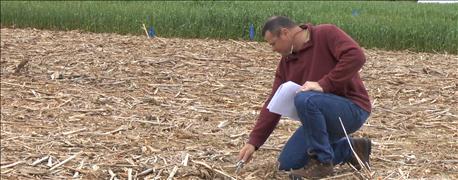May 30, 2016

Over the past two years, the On-Farm Network has been testing seed treatment impact on soybean growth and development. It is part of a validation program of products first tested at the Penn State University Experiment Station in small randomized, replicated plots.
Penn State Extension educators coordinate on-farm plots with growers to verify results. This year, we’re testing five soybean varieties from Pioneer, Asgrow, Seedway, Doeblers, Syngenta, and Mid Atlantic Seeds.
We’re comparing treated soybeans vs. the same variety and seed lot with no seed treatments.

TOUGH TESTS: 2016 spring conditions may be the “acid test” for seed treatment trials, suggests Penn State’s Del Voight.
Seed treatments, as we define them, are commercial applications containing an insecticide and a fungicide. This whats_on_your_seed web link has very useful details.
And the results were...
In 2014, the seed treatment results of 92 On-Farm Trials indicated a significant response in early-planted soybeans – planted before May 10. Later plantings weren’t significantly different in yield. However in all planting dates, population counts were significantly different between treated and untreated seed.
2014 On Farm Seed Treatment Results
Overall | Treated | Untreated | Significance |
Population | 116,547 | 108,032 | Yes |
Growth | 36 | 34 | NS |
Yield | 62 | 59 | NS |
In 2015, there were no significant yield results in the 86 trials. But treated plant populations were significantly higher.
2015 On-farm Seed Treatment Results
Overall | Treated | Untreated | Significance |
Population | 124,209 | 103,672 | Yes |
Growth | 35 | 33 | No |
Yield | 59 | 57 | No |
Two years of data suggests a significant difference in population by using fungicide/insecticide seed treatments. It appears that seed treatments save about 15,000 plants per acre that would normally be lost if the seed had been planted untreated.
2016 will be the final year of this project. Currently, 15 on-farm cooperators are scheduled to participate. To see the seed treatment video taken at the Southeast Experimental Center click on seed treatment trials
2016 update
The Soybean Response to Seed Treatment Trial is located at the Southeast Ag Research and Extension Center in Lancaster County, near Landisville, Pa. Trial plots were planted in 15-inch rows with a White corn planter on April 26. Since then, there has been 44% more rainfall than average and 46% less heat units compared to normal.
As of May 17, the soybeans are struggling to emerge. We’ve noted some dampening off of soybeans in the plots. And while the field is no-tilled into corn stalks, there was significant crusting. We’re conducting pop-up population counts t
his week, and will begin assessing seed treatment impact on population and height.
About this weekly network reportThis Pennsylvania Soybean Research On-Farm Network report centers on applied research projects of interest to Pennsylvania soybean growers. It’s a collaborative effort of the Pennsylvania Soybean Board and Penn State Extension. This is the first in a weekly growing season series.
A portion of the check-off funds from every bushel of soybeans sold in Pennsylvania is allocated for research to benefit soybean farmers for increasing utilization or production of soybeans. The Soybean Check-Off board of directors is comprised of soybean farmers from across the Commonwealth who determine research priorities.
The On-Farm Network project, spearheaded by Penn State Extension’s Voight, provides real-life, on-farm production-scale data to aid farmers in ongoing crop management decision-making. Farms throughout Pennsylvania with varying field, equipment and crop conditions contribute to the project’s data.
You May Also Like




